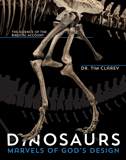
Bird X-Rays Shed Light on Dinosaur Tracks
News to Know
Abstract
Can walking birds trace tracks back through the sands of time and correct some false impressions of dinosaurs?
News Source
- LiveScience: “Secrets of Dinosaur Footprints Revealed in Bird X-Rays”
By devising a ground-breaking technique to peer beneath the surface as a bird’s feet make tracks, Brown University scientists Peter Falkingham and Steven Gatesy have discovered how to reap a wealth of information from that delightful paleontological prize, the fossilized footprint of a dinosaur.
You can tell a lot about animals and people by examining their footprints. And when the trackmakers—such as dinosaurs—are long gone, fossilized footprints are the only way we have to assess how they moved. Clues about their anatomy, their gait, and perhaps even their behavior are locked away in stone.1 Could the memory of the very motion that pushed and piled up particles of mud or sand be somehow preserved in the prints?

Falkingham and Gatesy X-rayed and filmed a bird walking through a trough of poppy seeds from multiple angles (A) producing views at and below the surface (B), which were combined to form 3-D animations simulating every detail of track formation. X-rays of the bird’s feet with pictures of its bones superimposed on them are shown in (C), and the difference between walking on a hard surface and soft one is depicted in (D). Scale bar = 20 cm. Be sure to watch videos of the animations at PNAS.org. Image: P. Falkingham and S. Gatesy, “The birth of a dinosaur footprint: Subsurface 3D motion reconstruction and discrete element simulation reveal track ontogeny,” Proceedings of the National Academy of Sciences (December 8, 2014): figure 1, doi:10.1073/pnas.1416252111.
Tracks Can Be Tricky
Dinosaurs on-the-go didn’t simply press their feet into cement like movie stars, yet the real Jurassic stars have left us no other way to learn how they moved. “Footprints are not just simple molds of the bottom of the foot,” explains Gatesy, “so it’s important to understand how the dynamic interaction between a living animal and the substrate give rise to a track’s 3D shape.”2
Tracks, like a blurred photograph, are distorted by the very motion that created them. This study showed that such motion can create false, anatomically incorrect impressions of the trackmaker’s foot. Additionally, erosion may spare only a track’s subsurface layers, which bear little resemblance to the trackmaker’s foot or the original track it made. Dinosaur tracks are seldom preserved with their owner, so how can we know whether the deeper ghosts of a track resemble the original foot? How do we decipher the distorted information memorialized in such stony remains?

This dinosaur track contains several curvy ridges (marked by the arrows) around a curved third digit. These marks are similar to marks made by the guineafowl’s foot deep beneath the surface that, rather than representing the shape of the bird’s foot, were instead artifacts of the bird’s toes clenching together as the foot was pulled from the soft substrate in the PNAS study. Therefore, it is most likely that the curves and ridges on this dinosaur’s track are also artifacts of motion and not anatomical impressions. Scale bar = 3 cm. Image: Falkingham and Gatesy, “The birth of a dinosaur footprint”: figure 4, doi:10.1073/pnas.1416252111.
Present Clues to Past Events
While we cannot observe how tracks were made in the past, Falkingham and Gatesy, using equipment in the Royal Veterinary College’s Structure and Motion Laboratory, analyzed prints made by a living animal in order to see how closely an actual print resembles the foot that made it. They found how the subtle flexion and splaying of the toes is cryptically reflected in a print. Moreover, by tracking the interaction between foot and sediment grain by grain, they correlated each portion of a track, even beneath the surface, with the motion that created it. And by visualizing a track’s subsurface secrets, they can now shed light on fossilized tracks from which the original surface layers have eroded. They hope to apply this information in reverse, to properly interpret the anatomy and motion reflected in dinosaur tracks.
Since fossilized dinosaurs are notoriously uncooperative when asked to demonstrate how they walked, Falkingham and Gatesy enlisted the cooperation of guineafowl, birds similar to chickens and pheasants, to answer these questions. “They are small dinosaurs without a tail, and that makes them a fantastic correlate for looking at the footprints produced by dinosaurs and produced by birds,” says Falkingham.3
“By observing how a footprint is formed, from the moment the foot hits the sediment until it leaves, we can directly associate motions with features left behind in the track,” Falkingham explains. “We can then study a fossil track left by a dinosaur and say ‘ok, these features of the track are similar, but these are different, so what does that mean for the way the animal was walking?’”2
This is a good moment to point out the contrast between the researcher’s unverifiable worldview-based belief—that birds evolved from dinosaurs—with the observable effects of foot motions on the sediment through which it walks. The latter may be reasonably applied to understand how a dinosaur track was probably made, but no amount of observations can support the notion that birds evolved from dinosaurs.
The Inside Tracks
By X-raying and filming a bird strolling through a trough of poppy seeds from multiple angles, Falkingham and Gatsey produced three-dimensional images of the otherwise invisible underground motion. Surface tracks were faint, but below the surface tracks were far more impressive. The researchers could even see how individual seeds locked one another in place beneath the surface, forming a reproducible subsurface record of the foot’s transit. However, neither the surface tracks nor the subsurface impressions provided an anatomically accurate image of the foot that made them. After putting all of this information into a computer model, they compared it to an actual dinosaur track and gained insight into what the original anatomy of the dinosaur’s foot likely was—and what it was not!
Decoding a Dinosaur Track
By comparing the subsurface simulation of the guineafowl’s track to a Lower Jurassic track, pictured above, made by the small dinosaur Corvipes lacertoideus, the researchers are now able to identify markings that likely represent not the dinosaur’s foot anatomy but its motion. This dinosaur is known from its tracks in Connecticut, but odd curves and ridges in the tracks have made knowledge of its actual foot anatomy elusive. The dinosaur track has an S-shaped third digit surrounded by three semicircular ridges. (The white arrows in the photo above point to the ridges.)
Neither the surface tracks nor the subsurface impressions provided an anatomically accurate image of the foot that made them.
“The simulation shows us that as the foot comes out, it comes out in the middle of the track and it pulls sediment upwards while it does so,” Falkingham explains. “So these [markings on the dinosaur track] are actually exit traces from the foot.”3 This technique may well change the way many dinosaur tracks are viewed. The authors write, “Other specimens of various sizes and ages described globally bear similar unexplained topography. Thus, we are able to link specific features of fossil dinosaur tracks to homologous features created by guineafowl ~200 million years later, despite differences in foot anatomy, limb movement, and substrate. Isolated track surfaces are prone to misinterpretation.”4
Limitations and Lessons of Models
Poppy seeds behave like dry sand, but because X-rays pass easily through seeds they made a great choice for this initial study. However, fossilized tracks must have formed in a wet, cement-like substrate. The researchers plan in the future to improve their model’s accuracy by simulating the differences between the dry poppy seeds and fine-grained mud.4
This new technique is a fine example of using observational science in the present to gain clues about the unobservable past. Even though birds differ from dinosaurs, and dry seeds differ from mud, the artifacts of motion seem to match quite well. But does the value of this technique have anything to do with the supposed kinship between dinosaurs and birds? Not at all. While many evolutionary scientists maintain that birds evolved from dinosaurs, the selection of a bird to make these tracks hinged not so much on evolutionary claims as on the simple fact that these birds have feet about the same size as the dinosaur print the scientists planned to use for comparison. Bird foot anatomy differs from a dinosaur’s, as did the substrate in which the prints were made. And while those facts must be kept in mind, the power of the model to provide a likely explanation for otherwise unexplainable impressions in many dinosaur tracks is evident.
The authors conclude, “An experimental and simulation-based understanding of track ontogeny [how tracks form] holds promise for releasing the full potential of fossil tracks to elucidate the evolution of dinosaur locomotion.”4 Yet here they have leaped from a motion study to imaginative speculation. Modelling the foot and leg motions that make a track can reveal nothing about the evolution of one kind of animal into another. Only evolutionary imagination connects the dots between different kinds of animals and presumes that dinosaurs had to evolve the ability to walk and run over millions of years instead of being created by God fully ambulatory about 6,000 years ago.
While the new technique provides a window into the long gone ways dinosaur feet moved as they pressed their prints into the mud, it also does not explain how such tracks, once made, could be fossilized in the first place. After all, footprints in rivers and on beaches would ordinarily wash away quickly, and the flash floods, often invoked to explain the absence of animals with their tracks, are uniformly destructive, washing away all in their path. Neither does anything in an evolutionary worldview explain how tracks could resist erosion for millions of years.
How Can a Footprint Fossilize?
As incredibly destructive as the global Flood was, it ironically explains how most footprints preserved in sediment deposited during the global Flood became fossilized in the first place, rather than being simply washed away.5 And since the Flood was only about 4,350 years ago, not millions of years ago, it is much easier to understand how such fossilized tracks have survived the forces of erosion for us to examine today. The circumstances surrounding the global Flood offered the perfect opportunity for the preservation of something as delicate as a footprint.
As the floodwaters rose over many days (Genesis 7:17–18), surging sediment-laden ocean water would have dumped mineral-rich mud, like a quick-set cement, over land soon to be covered again by water. Into this sort of substrate animals trying to flee the rising, falling, rising again and surging waters (like those in tsunamis) would have pressed their prints. The shape of the prints would have been very quickly preserved because of the water and cement holding and cementing the sediment grains together. Additional surges of sediment-laden water then must have rapidly buried these tracks, infilling the shapes of the tracks with more cement-like mud and thus rapidly preserving the tracks. This Flood model of track fossilization also explains why tracks are rarely preserved with their owners. Fleeing animals overwhelmed by the subsequent surges of water would usually be carried away for burial elsewhere.
This study describes a powerful new technique, but we must keep in mind what the technique can and cannot reveal. It can show how certain motions—regardless of the identity of the animal making them—can produce certain impressions, but it cannot tell us anything about the origin of that animal or how locomotion evolved. It does not support an evolutionary connection between birds and dinosaurs. It cannot explain how dinosaur tracks were fossilized in the first place. Furthermore, tracks preserved under catastrophic Flood-related conditions are unlikely to tell us about the ordinary daily lives of their owners but more correctly reflect their locomotion in a time of crisis and chaos. To truly make sense of the unobservable past, we need a historical eyewitness account of that time, and that comes from God’s Word. Those answers are in Genesis.
Further Reading
- Alaskan Dinosaur Tracks Buried in the Global Flood
- Fossilized Footprints—A Dinosaur Dilemma
- Do Duck-Billed Dinosaur Tracks Trace Hadrosaur Habits?
- Discovering the Cause of Giant Dinosaur Stampede
- Dinosaur Stampede Version 2.0
- Ancient Footprints Place Humans in England Early in the Ice Age
- Laetoli Footprints Revisited
- Why Don’t We Find Human & Dinosaur Fossils Together?
- Did Dinosaurs Turn into Birds?
For More Information: Get Answers
Remember, if you see a news story that might merit some attention, let us know about it! (Note: if the story originates from the Associated Press, FOX News, MSNBC, the New York Times, or another major national media outlet, we will most likely have already heard about it.) And thanks to all of our readers who have submitted great news tips to us. If you didn’t catch all the latest News to Know, why not take a look to see what you’ve missed?
(Please note that links will take you directly to the source. Answers in Genesis is not responsible for content on the websites to which we refer. For more information, please see our Privacy Policy.)
Footnotes
- Even the placement of prints in trackways offers clues to the behavior of the animals that made them—were they running or walking? Moving in the same direction or chaotically? Were they mixing with other animals at the time or keeping to themselves? Do they appear to be fleeing from predators or trying to escape some now unseen disaster? However, even with excellent technical analysis, a scientist’s bias will inevitably play a role in the interpretation of the circumstances surrounding the event that stamped some footprints in time. For instance, paleontologists often attribute tracks to a flash flood that swept away animals by a muddy riverbank. However, flash floods are known for washing away everything in their paths, not for preserving prints for posterity. While the global Flood was far more destructive than any flash flood, it actually does an excellent job of explaining how footprints became fossilized in the first place. And since the Flood was only about 4,350 years ago, not millions of years ago, it is much easier to understand how such fossilized tracks, so easily eroded once they are exposed, have survived for us to examine today. The circumstances surrounding the onset of the global Flood offered the perfect opportunity for that most fortuitous event—the preservation of something as delicate as a footprint—to take place and also help explain the behavior that likely accompanied many of the track-making events. You can read more about this in “Alaskan Dinosaur Tracks Buried in the Global Flood,” “Fossilized Footprints—A Dinosaur Dilemma,” “Discovering the Cause of Giant Dinosaur Stampede,” “Dinosaur Stampede Version 2.0,” and “Do Duck-Billed Dinosaur Tracks Trace Hadrosaur Habits?”
- “The Birth of a Dinosaur Footprint: New Research Explores How Fossil Tracks Are Formed,” Royal Veterinary College, last updated December 9, 2014, http://www.rvc.ac.uk/news-and-events/press-office/the-birth-of-a-dinosaur-footprint.
- Stephanie Pappas, “Secrets of Dinosaur Footprints Revealed in Bird X-Rays,” LiveScience, December 8, 2014, http://www.livescience.com/49047-dinosaur-footprints-bird-x-rays.html.
- P. Falkingham & S. Gatesy, “The birth of a dinosaur footprint: Subsurface 3D motion reconstruction and discrete element simulation reveal track ontogeny,” Proceedings of the National Academy of Sciences (December 8, 2014): doi:10.1073/pnas.1416252111.
- The fossil record also contains examples of footprints fossilized in layers of mineral-rich sediment or volcanic ash after the global Flood. Read more about some of these in “Ancient Footprints Place Humans in England Early in the Ice Age” and “Laetoli Footprints Revisited .”
Recommended Resources

Answers in Genesis is an apologetics ministry, dedicated to helping Christians defend their faith and proclaim the good news of Jesus Christ.
- Customer Service 800.778.3390
- © 2024 Answers in Genesis





